Brighton had a truly momentous season, exceeding expectations in all areas to gain promotion back to the Premier League for the first time in 34 years. In doing so Brighton’s losses increased by a remarkable 50% to £38.9m, although £9.1m of this can be attributed to administrative & regulatory costs of readying the club for the Premier League. Revenues rose over £4.6m (18%) to £29.2m.
Spending was required to reach their goals and the club has been rewarded as Chairman Tony Bloom has already commented that “Our annual turnover has been boosted by approximately £100m for the current season”, more than triple current levels.
This article will analyse the different aspects of their financial performance and the investment they put into gaining promotion for a usually conservative club.
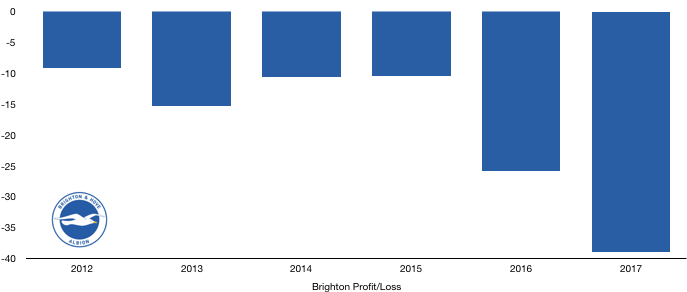
Revenue Analysis
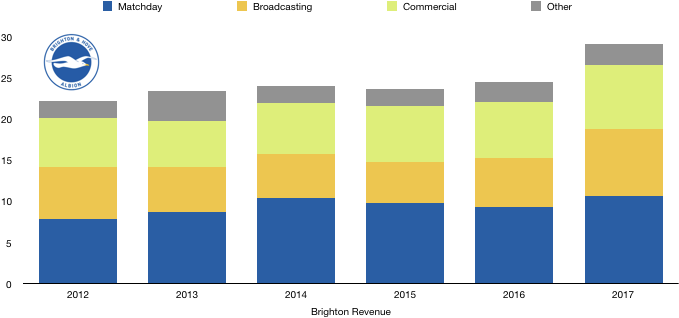
Brighton’s revenue reached record levels of £29.2m, up a good 18% from the previous year due to their incredible promotion campaign where they were unbeaten for the first 18 games of the season. This feat helped keep fans coming to their stadium, while attracting commercial attention and also keeping TV cameras on the team for crucial games.
Brighton’s commercial revenue had a modest rise of £400k (7%), with a larger rises expected in the next account once Brighton secure more lucrative partnerships due to their newfound Premier League status.
Being in the promotion race helped Brighton secure more televised matches for their games, leading to a £2.2m rise (36%) rise in broadcasting revenue. Increased prize money and live games will have been awarded to Brighton over the course of the promotion season, boosting these revenues. Brighton Received £7.6m from the Football League last season, this pales in comparison to the riches they will now receive in the Premier League.
Matchday revenues were up £1.3m (14%) as fans flocked to support their teams rise to the Premier League, such exciting prospects always bring in more fans and help the club increase spend by fans on matchday too. Matchday revenues would have risen further if not for poor domestic cup runs, reaching the 4th and 3rd round of the FA Cup and League Cup respectively as they rightfully prioritised promotion.
Expense Analysis
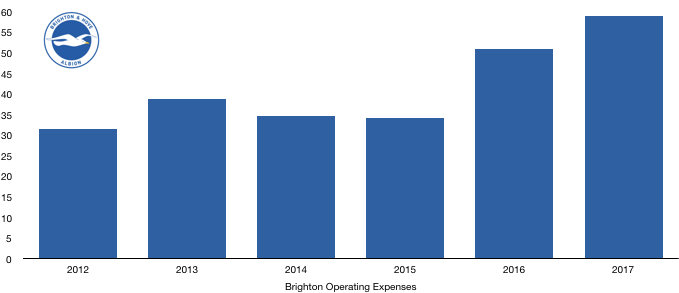
Operating expenses rose £8m to £59m (15.7%), this is before taking into account exceptional costs incurred in readying the team for the Premier League of £9.1m, which takes the increases in costs to 33.5%. There are certain Premier League requirements in order to get a team ready for the league such as extra facilities, enhanced pitch quality etc. Since Brighton have been away from the Premier League for so long, the requirements are hence more burdensome and require a significant cost to the team.
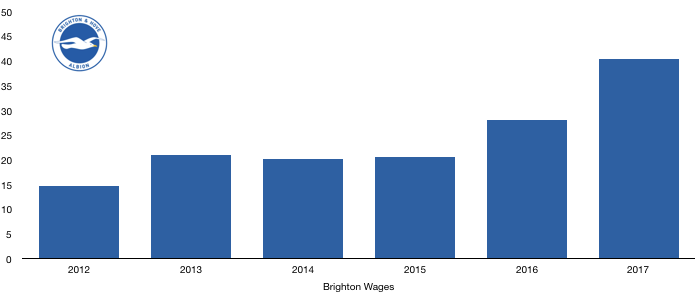
Wages rose significantly as the club pushed for promotion, seeing new faces join the club with no one important leaving, leading to wages rising 43% to a record £40.4m.
Total staff numbers rose by 18 to 288 (7%), with playing staff and coaches up by 5 to 78 (7%).
Player amortisation costs rose to £6.3m from £3.8m (6%) due to high transfer fees and no significant outgoing transfers, which will have an adverse effect on Brighton’s ability to comply with Financial Fair Play.
Transfer Analysis
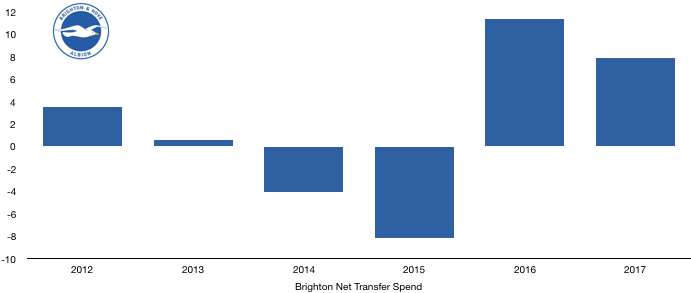
Brighton had a successful transfer period, bringing in 3 players at a cost of £7.9m, with the highlights being Shane Duffy (£4.7m) and Glenn Murray (£3.2m). Steve Sidwell also arrived on a free transfer, contributing to the significant wage rise.
Brighton goal was to keep their squad together while adding a bit of quality in key areas which they were successful in doing, warding of interest for key players Anthony Knockaert, Lewis Dunk and Dale Stephens. The Chairman highlighted this in the accounts that “Retaining our key players from the previous season was vital, and we rejected significant bids for the trio”.
This resulted in the club selling no players for any transfer fee, releasing Gordon Greer, Iñigo Calderón, Andrew Crofts and Adam Chicksen. This meant no players left for money for the second season in a row.
Interestingly the net spend was lower than their high of last season that built the foundation for their successful campaign this season.
These two seasons marked a change in ambition for the usually conservative Brighton, after three years of minimal spend and this looks to be continuing after spending £42.8m in the summer. They also broke their transfer record three times to sign Mathew Ryan (£5.4m), Davy Pröpper (£11.7m) and then José Izquierdo (£13.5m)
This took Brighton to having the 16th highest net spend of £7.9m, despite not being a Premier League club last season.
Assets & Liability Analysis
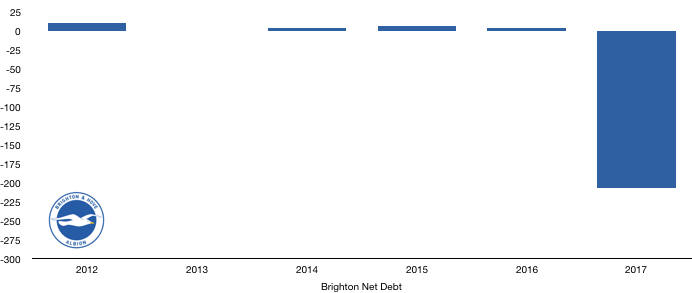
Brighton’s debt level rose considerably in the last year with cash reserves depleted due to rising costs, taking advantage of their overdraft to the tune of £16.2m. In 2016, they had cash of £4.5m, therefore this is a fall of over £20m.
Brighton have little in the way of debt other than to their owner on interest free loans that we will talk about below, with only £140k of such loans last year and the year before.
Tony Bloom, Owner of Brighton has invested a significant amount in the new Premier League club, contributing over £190m of his own cash into the club, and he is beginning to reap the rewards of that investment now.
Over the last year he increased loans to the club of £20.2m, helping the club meet their growing costs as they pushed for promotion. Each year, Tony Bloom has consistently invested between £15-30m, contributing significantly to their journey to the Premier League.
The dip in 2013 can be explained in a similar way to Chelsea’s loans as Tony Bloom converted £40m of loans to equity, amounts he will only regain as the club turn to profit.
This is unlikely to be an issue to the owner Tony Bloom, a Brighton born individual who has great love for the club and is likely to remain at the club for the foreseeable future.
Thanks for reading – Share with your fellow Brighton Fans!

